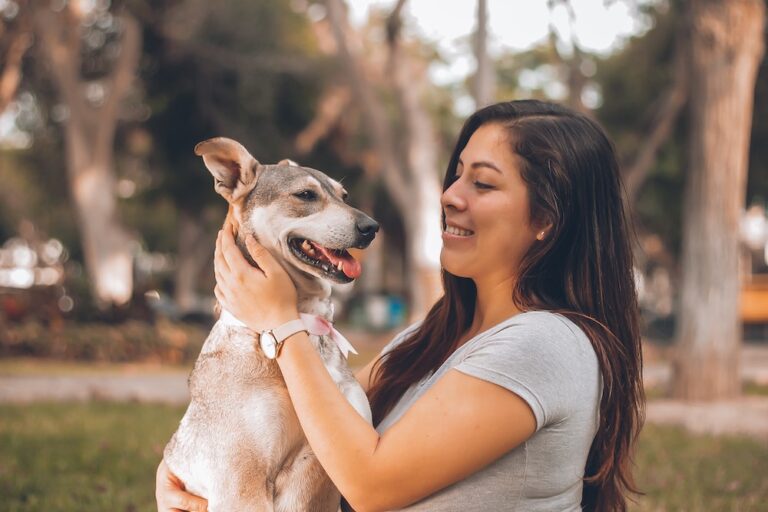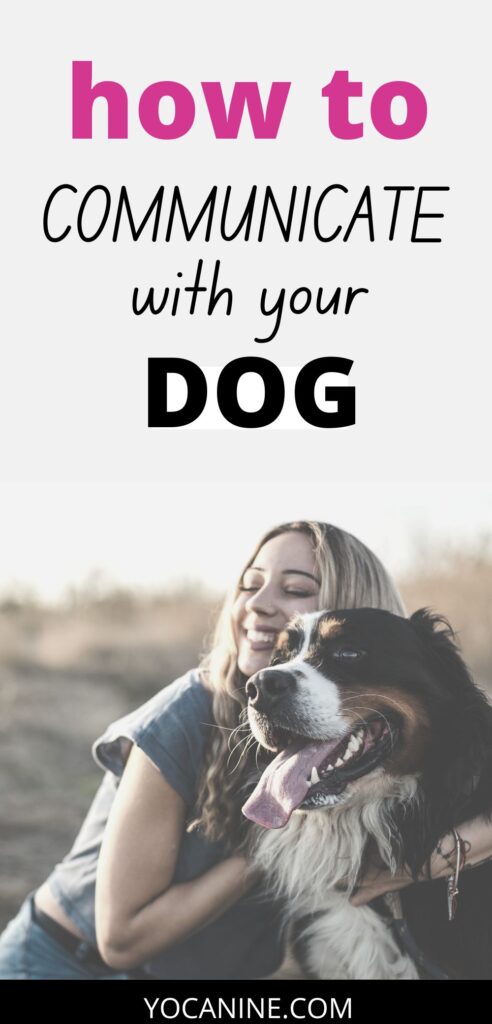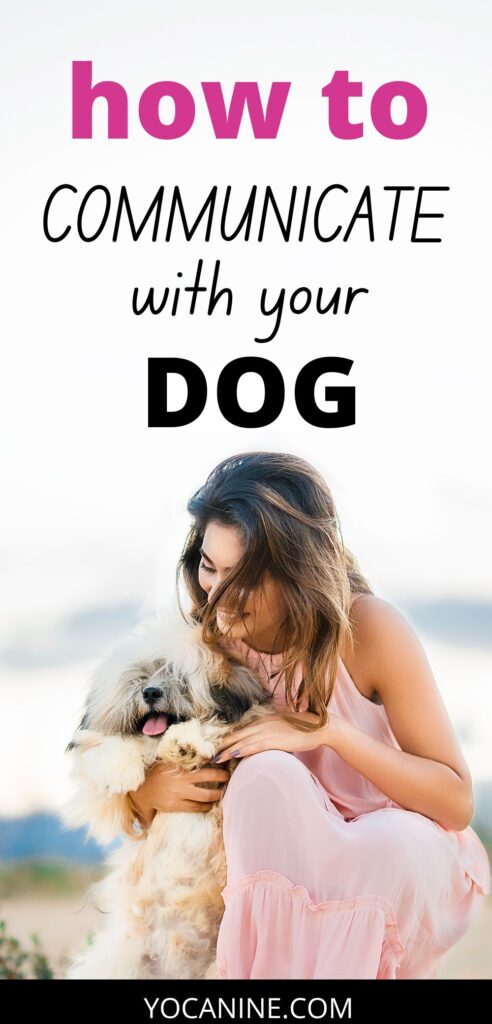
What would your dog say if she could?
We’ll never know, but we can get closer by practicing the tips we’ll share in this post.
Communicating with a dog is a skill we need to learn and build with our canine companions.
Although it’s not easy as simply talking, we can grow toward understanding each other and reading our pup’s signs.
In this article, we’ll share how to communicate with your dog using 12 tips.
How to Communicate with Your Dog: 12 Tips

Learning how to communicate with your dog is important because you want to understand each other. Although a large part of talking to your canine involves training, much of it involves training yourself too. Read on to learn how.
#1 Use Hand Actions
When you want to communicate with your dog to do something, the best way is to teach her the behavior and attach it to a hand gesture. For example, an open hand up could mean sit.
Of course, your dog won’t automatically know what an open hand means. So if you do it, she won’t respond to it at all. First, get her to do the behavior first. To do this, you can search the trick or action on YouTube. Then when your dog is doing the behavior, add in the hand gesture. Repeat it several times during the first session and keep reinforcing the trick in future sessions.
Once she learns the trick, you will be able to communicate with her which actions and behaviors you want her to do in that moment.
#2 Congratulate Your Dog on a Good Trick
When you’re teaching your dog to do a trick, you need to let her know when she’s done the right thing. Giving her a treat as a reward is a great idea, but it should also be accompanied by one word you can use to say “that’s correct.”
You can use the word “yes” or “good boy!” or “so smart!” It matters less what word you use and matters more that you use it consistently.
When your dog learns that your selected word means “correct,” you can easily communicate with her when she’s doing the right thing. And in reverse, she’ll also know when she’s not doing the right trick or action.
#3 Add Words to Your Dog’s Actions
Once your dog has learned a tick, you can introduce her to the word for it. For example, once your dog learns to sit, you can say “sit” and begin to train her about what it means.
Some people try to introduce their dog to words at the beginning of their trick. This can be a mistake because your dog doesn’t even know the action yet. It’s better to get her to learn the action first, and then learn the word for it. This makes it easy to give her commands and communicate with her, even if she’s in the other room and can’t see hand signals.
#4 Reconsider Using “Stop”
Many dog owners, including myself, automatically use the word “stop” when their dog is doing something bad. But to be honest, it’s not the best way we could deal with the situation. Sometimes it works, sometimes it doesn’t. The important thing to realize is that “stop” isn’t a standard trick that you teach your dog. “Stop” can mean something different each time, so that can be hard to train.
Instead, show your dog what to do instead when she’s doing a bad behavior. In other words, replace the bad behavior with a good one.
For example, every time your dog jumps up on a guest, ask her to sit and stay instead. The first several times, you will need to command and teach her so that she understands what you’re trying to communicate. But in time, it will likely become a habit and she should stop jumping up, or at the very least, sit after the first jump.
Another common example is if your puppy is teething and keeps biting you. Instead of expecting them to understand what “stop means,” give them a toy and encourage them to play with it.
Saying “stop” can be vague for a dog. When we teach them to do another action instead, we can get them to cease the behavior long-term.
#5 Prioritize Non-Verbal Communication
You can talk your dog’s ear off all she wants and she might pretend she’s listening, but that’s not really a way she communicates. Dogs mainly communicate non-verbally, which means by body language.
So, when you want to send your dog a message, get her to do something, get her to stop doing something, or even just to give her praise and love—non-verbal is always the best way.
That doesn’t mean your dog can’t understand words. Of course, she can respond to words you train her and maybe even some words you don’t. Words are important too. But the most effective means of understanding and talking to your dog will always be through body language.
#6 Look at Body Language in Context
There’s tons of charts that show you what your dog’s body language is supposed to mean. For example, most people agree that a wagging tail is a happy dog. However, any body language should be looked at in context. For example, if your dog is wagging her tail but her ears are pinned back and she’s frozen, those signals are saying the opposite.
To understand your dog and communicate with her better, take her situation and all body language into account.
#7 Learn Dog Body Language
Once we consider the factors in reading our dog’s body language, we can begin to learn the signs. You probably already know many because it comes intuitively to you. Over time, if you watch your dog, you’ll begin to learn what different signals learns because you’ll notice a pattern.
For example, when my dog needs to go outside to the bathroom, he paces back and forth in the living room. It’s his way of communication to me that he needs to go. Other dogs might stand at the door, stare at you or bark. If you pay attention, you can usually notice patterns that link some behaviors/needs to an action.
Here’s a general rundown of dog body language:
- Anxious- Panting, pacing, ears pinned back, repeat yawning and licking their lips excessively.
- Aggressive– Showing teeth, stiff body, intent gaze/stare, tail standing up and growling.
- Relaxed- Head and ears in neutral position, tail wagging, exposing belly, relaxed body and mouth.
Keep in mind that your dog can have the same body language signal for 2 different emotions.
#8 Look Into Your Dog’s Eyes
How often have you heard the phrase, “look me in the eyes when I’m talking to you?”
The same is true for dogs. We might become too comfortable with ordering commands from afar or using a leash, but really, we need to look our dogs in the eyes too. As explained in the video below, humans communicate a lot through their eyes, so we bred dogs that were good at communicating through their eyes too.
Next time you’re talking to your dog or asking her to act in a certain way, try looking into her eyes.
#9 More Petting
Most dogs LOVE being pet and getting belly rubs. What can communicate love to an animal more than making them feel good?
Get to know the places your dog absolutely loves being pet or massaged. The action helps them feel safe and connected to you.
#10 Licking is Love
Sure, dog slobber can be annoying. But if a dog licks you, it probably means they love you. Although not all dogs do this, many pups are known to be constant lickers if they like you.
If you go to pet your dog and they snap back with a lick, it means they’re saying “I like you too.”
#11 Pay Attention to Tone
When you’re talking to your dog, make sure to pay attention to your tone and adjust it according to the situation. This will help your dog process what you’re saying and which type of mood he should project.
For example, when you’re asking your dog to do something instead of a bad behavior, it can be best to use a firm, assertive voice. That can help communicate with your dog that you’re serious and not joking around anymore. But if you’re having a playful session, you can transition to a normal or playful voice.
There’s exceptions though. For example, if you want your dog to pay attention when she’s interested in something else, using a high pitch sound can keep their focus. Studies show that, similar to babies, using a high pitch voice with puppies can promote learning and engagement.
#12 Don’t Fake Your Energy
It might sound a little ethereal, but dogs can read your energy even if you don’t think they can. That means that when you’re trying to fake an emotion, they can feel it and will respond accordingly.
For example, let’s say you’re trying to train your dog how to do a trick. It’s taking a long time and she’s not getting it no matter what you do, so naturally, you become frustrated. Even though you’re upset and becoming impatient, she can feel it and her energy begins to become a little more erratic too.
Now, compare this situation to what would happen if you became impatient, took a break and then came back with sincerity. Your dog can read this and have a calmer energy too.
Summary on How to Communicate with Your Dog
Since dogs are different animals, how we communicate with them should be different. Also, they can’t talk, so there’s that too. But by reading body language, teaching them words, and keeping out energy in check, we can learn how to communicate with your dog. The tips in this post can be practiced over time to build a good relationship with your canine pal.
